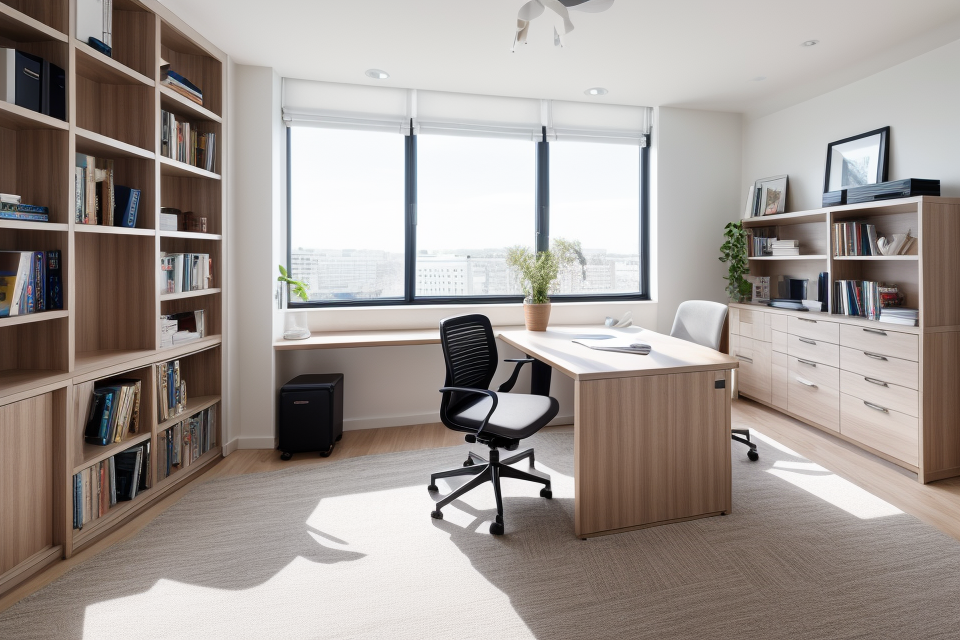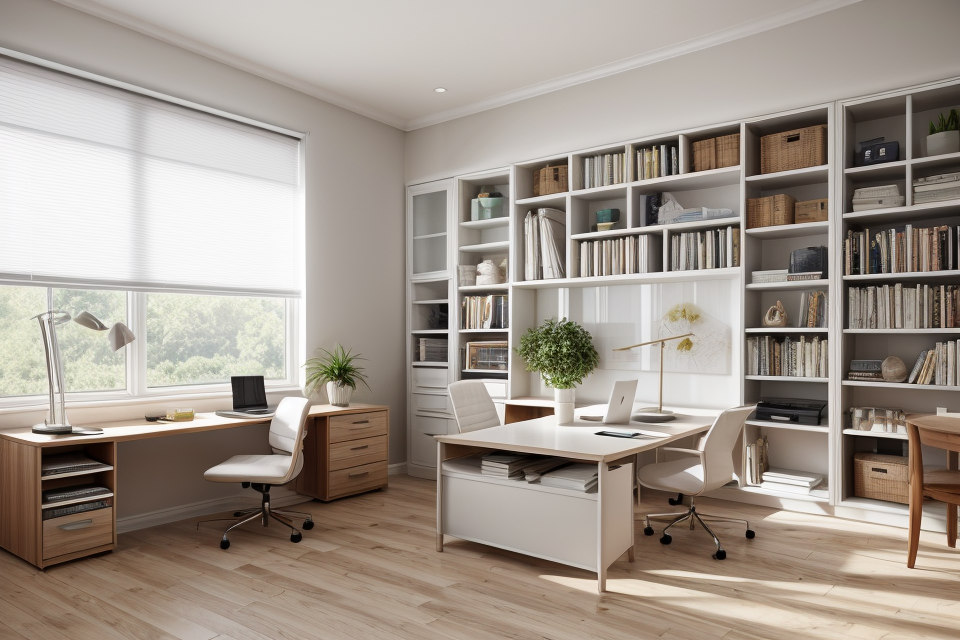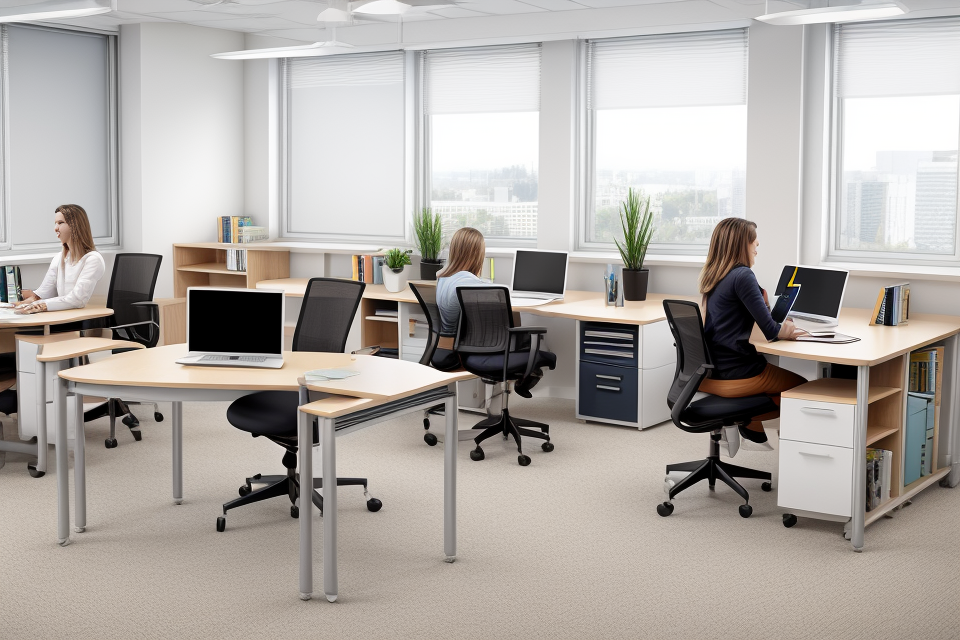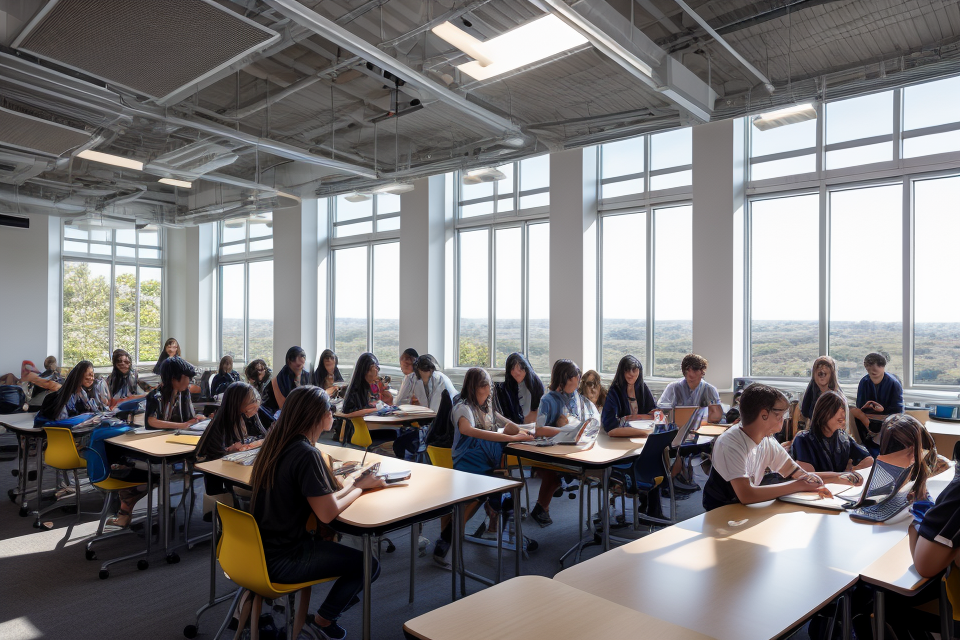
Achieving academic success is a goal that every student strives for. However, the journey to success is not always smooth sailing. One of the key factors that can make or break a student’s academic performance is their study environment. A well-designed study environment can boost a student’s motivation, concentration, and productivity, while a poorly designed one can lead to distractions, stress, and burnout. In this article, we will explore the importance of a good study environment and provide tips on how to create one that maximizes academic success.
Creating the Ideal Study Space
Factors to Consider
Ergonomics
- Proper body posture to prevent discomfort and minimize the risk of injury
- Adjustable furniture to accommodate different tasks and activities
- Access to electrical outlets and USB ports for charging devices
Lighting
- Adequate and appropriate lighting for reading, writing, and other study-related tasks
- Adjustable lighting to suit different times of day and weather conditions
- Avoid harsh or flickering lights that can cause discomfort and distractions
Noise level
- Quiet and peaceful environment to minimize distractions and improve focus
- Background noise that is not intrusive and can enhance creativity and productivity
- Soundproofing materials to reduce noise pollution from outside sources
Ventilation
- Proper ventilation to maintain a comfortable temperature and humidity level
- Good air circulation to prevent the buildup of allergens, bacteria, and viruses
- Air purifiers or filters to remove harmful pollutants from the air
Space utilization
- Maximizing the use of available space to create a functional and organized study area
- Proper storage solutions for books, notes, and other study materials
- Minimizing clutter and distractions to maintain focus and productivity
Setting Up Your Workspace
- Arranging Your Study Area: The first step in setting up your workspace is to arrange your study area in a way that promotes productivity and reduces distractions. Consider the amount of natural light, the placement of furniture, and the flow of traffic in the room.
- Selecting Appropriate Furniture and Equipment: Once you have arranged your study area, the next step is to select appropriate furniture and equipment. This includes a comfortable chair, a desk or workspace, and adequate lighting. It is also important to have access to power outlets to charge electronic devices.
- Incorporating Technology: In today’s digital age, technology plays a crucial role in the study environment. Consider incorporating technology such as a computer, a printer, and a scanner. Additionally, consider using software and apps that can enhance your study experience, such as note-taking apps and study planners.
Overall, setting up your workspace is crucial in creating an ideal study environment. By carefully considering the arrangement of your study area, selecting appropriate furniture and equipment, and incorporating technology, you can set yourself up for academic success.
The Impact of a Well-Designed Study Environment on Learning Outcomes
Enhancing Focus and Concentration
- Reduce Distractions: A conducive study environment eliminates potential distractions that can negatively impact concentration. This may involve selecting a quiet space, avoiding distracting objects or noises, and limiting access to electronic devices that may tempt the student to engage in non-academic activities.
- Boost Motivation: A well-designed study environment can enhance motivation by creating a sense of purpose and structure. For instance, organizing study materials and resources in an aesthetically pleasing manner can inspire students to engage in focused and productive study sessions.
- Facilitate Effective Study Habits: A study environment that supports focused concentration can also promote effective study habits. This includes establishing routines, setting goals, and tracking progress. By creating a physical space that encourages concentration, students can develop habits that foster academic success and lifelong learning.
Encouraging Productivity and Efficiency
A well-designed study environment plays a crucial role in promoting productivity and efficiency among students. By creating an optimal learning space, students can focus on their studies, minimize distractions, and make the most of their study time.
One of the primary benefits of a well-designed study environment is the ability to streamline workflow. This means organizing study materials, notes, and resources in a way that is easy to access and use. By eliminating clutter and creating a system for organization, students can reduce the time spent searching for materials and increase the time spent on actual studying.
Improving time management is another critical aspect of a well-designed study environment. By setting aside specific times for studying, breaks, and other activities, students can create a structured routine that promotes efficiency and productivity. Additionally, using tools such as calendars, to-do lists, and alarms can help students stay on track and make the most of their study time.
Finally, a well-designed study environment can promote better study techniques. By eliminating distractions, creating a comfortable and conducive atmosphere, and organizing study materials, students can focus on their studies and develop effective study habits. This can lead to improved comprehension, retention, and overall academic success.
Overall, a well-designed study environment is essential for maximizing academic success. By promoting productivity, efficiency, and effective study techniques, students can make the most of their study time and achieve their academic goals.
Fostering Creativity and Innovation
- Cultivating a conducive atmosphere for brainstorming: A well-designed study environment encourages brainstorming sessions by providing an inviting space that promotes collaboration and idea sharing. This can be achieved through the strategic use of lighting, furniture arrangement, and visual aids that inspire creative thinking.
- Stimulating out-of-the-box thinking: By creating an environment that challenges traditional ways of thinking, students are encouraged to think critically and explore new ideas. This can be achieved by incorporating diverse learning materials, promoting interdisciplinary studies, and fostering a culture of experimentation and risk-taking.
- Encouraging interdisciplinary connections: A well-designed study environment fosters interdisciplinary connections by providing opportunities for students to explore various fields of study and apply their knowledge in novel ways. This can be achieved by integrating different subject areas, offering interdisciplinary courses, and providing access to resources that encourage cross-disciplinary exploration.
Balancing Privacy and Collaboration in Your Study Environment
Benefits of Collaboration
- Sharing ideas and knowledge: Collaboration provides an opportunity for students to share their thoughts, ideas, and knowledge with one another. This can help students to broaden their understanding of the subject matter and gain new insights that they may not have considered on their own.
- Gaining different perspectives: Working with others allows students to see things from different angles and to consider alternative viewpoints. This can be particularly useful when tackling complex problems or trying to solve a difficult concept.
- Enhancing group dynamics: Collaboration can help to build stronger relationships among classmates, fostering a sense of community and cooperation. This can make the learning experience more enjoyable and can help to create a more positive academic environment.
Importance of Privacy
- Providing personal space for focused work
- The importance of having a personal space cannot be overstated when it comes to maximizing academic success. Having a designated area where you can work without distractions can greatly improve your productivity and focus.
- A study conducted by the University of California, Los Angeles, found that students who worked in a cluttered environment had a harder time focusing and were more likely to feel stressed.
- A separate study by the University of Minnesota found that students who worked in a quiet, personal space were more likely to feel calm and relaxed, which in turn helped them perform better on exams.
- Avoiding distractions and interruptions
- One of the biggest benefits of having a personal space for focused work is the ability to avoid distractions and interruptions. Whether it’s the noise from other students or the constant buzz of your phone, distractions can greatly hinder your ability to focus and learn.
- A study by the University of Texas at Austin found that students who worked in a quiet, personal space were able to complete their work more quickly and with fewer errors than those who worked in a noisy environment.
- Maintaining mental health and well-being
- In addition to improving academic performance, having a personal space for focused work can also help improve mental health and well-being. Studying in a cluttered or noisy environment can be stressful and overwhelming, which can lead to anxiety and other mental health issues.
- A study by the University of Illinois at Urbana-Champaign found that students who worked in a quiet, personal space reported feeling less stressed and more relaxed than those who worked in a noisy environment.
Overall, having a personal space for focused work is crucial for maximizing academic success. By providing a quiet, clutter-free environment, students can improve their productivity, focus, and overall mental health and well-being.
Adapting Your Study Environment to Your Learning Style and Needs
Understanding Your Learning Style
Understanding your learning style is crucial in creating an effective study environment. Learning styles refer to the unique ways in which individuals process and retain information. There are four main learning styles: visual, auditory, kinesthetic, and multimodal.
Visual Learning Style
Individuals with a visual learning style prefer to process information through visual aids such as diagrams, maps, and charts. They tend to retain information better when they can see it rather than hear it. A well-designed study environment for a visual learner would include plenty of visual aids, highlighters, and color-coding systems.
Auditory Learning Style
Auditory learners prefer to process information through listening and speaking. They tend to retain information better when they can hear it rather than see it. A well-designed study environment for an auditory learner would include recorded lectures, podcasts, and study groups.
Kinesthetic Learning Style
Kinesthetic learners prefer to process information through physical movement and hands-on activities. They tend to retain information better when they can touch and manipulate objects. A well-designed study environment for a kinesthetic learner would include study materials that allow for hands-on interaction, such as models, simulations, and physical experiments.
Multimodal Learning Style
Multimodal learners prefer to process information through a combination of different learning styles. They tend to retain information better when they can use multiple senses to process it. A well-designed study environment for a multimodal learner would include a variety of study materials, such as visual aids, audio recordings, and hands-on activities.
Understanding your learning style is the first step in creating a study environment that maximizes your academic success. By tailoring your study environment to your unique learning style, you can optimize your ability to retain and understand information.
Catering to Your Unique Needs
- Customizing your study area
- Incorporating your preferred learning tools
- Adapting your study schedule
Customizing your study area
- Creating a conducive atmosphere
- Organizing your study space
- Incorporating ergonomic principles
Creating a conducive atmosphere involves minimizing distractions and optimizing the physical environment to enhance focus and productivity. This may involve selecting a quiet location, utilizing appropriate lighting, and maintaining a comfortable temperature.
Organizing your study space is crucial for optimal performance. This includes arranging furniture and equipment to facilitate easy access to materials, maintaining a clutter-free environment, and displaying visual aids such as calendars and to-do lists to help prioritize tasks.
Incorporating ergonomic principles is essential for preventing discomfort and injury during extended study sessions. This involves selecting appropriate seating, ensuring proper posture, and utilizing adjustable furniture to accommodate varying study activities.
Incorporating your preferred learning tools
- Identifying effective study tools
- Selecting tools that align with your learning style
- Experimenting with new tools to enhance learning
Identifying effective study tools involves researching and evaluating various resources, such as note-taking apps, study guides, and online resources, to determine their suitability for your specific needs.
Selecting tools that align with your learning style is critical for maximizing the effectiveness of your study sessions. This may involve utilizing visual aids for visual learners, interactive tools for kinesthetic learners, or audio resources for auditory learners.
Experimenting with new tools to enhance learning involves trying out different techniques and resources to identify those that work best for you. This may involve incorporating new apps, joining study groups, or seeking out tutoring services to supplement your learning.
Adapting your study schedule
- Assessing your available time
- Balancing academic commitments with other responsibilities
- Scheduling breaks and downtime
Assessing your available time involves determining the amount of dedicated study time you have each day or week, as well as any potential interruptions or conflicts.
Balancing academic commitments with other responsibilities is essential for maintaining a healthy work-life balance. This may involve setting priorities, delegating tasks, or seeking support from family and friends to manage competing demands.
Scheduling breaks and downtime is important for preventing burnout and maintaining focus during study sessions. This may involve incorporating exercise, socializing, or engaging in hobbies as part of your study routine. By adapting your study environment to your unique needs, you can optimize your academic success and enhance your overall well-being.
Overcoming Challenges and Limitations in Your Study Environment
Addressing Common Issues
When it comes to creating an optimal study environment, there are several common issues that students may face. Addressing these challenges and limitations is crucial to maximizing academic success. Here are some ways to overcome these obstacles:
Limited Space
One of the most common issues that students face is limited space. Whether it’s a small dorm room or a shared living space, finding a quiet and comfortable area to study can be challenging. Here are some tips to make the most of a small space:
- Utilize vertical space by hanging shelves or storage units to hold books and supplies.
- Invest in a portable workstation or desk that can be moved to different areas of the room.
- Use noise-cancelling headphones to block out distractions and create a quiet study environment.
Distractions
Distractions are another common issue that can impact academic success. Whether it’s social media, TV, or friends and family, there are many things that can distract students from their studies. Here are some ways to minimize distractions:
- Create a study schedule and stick to it, designating specific times for studying and other activities.
- Use apps or browser extensions that block certain websites or limit screen time.
- Study in a quiet, distraction-free environment, such as a library or study room.
Lack of Resources
Finally, some students may face a lack of resources, such as textbooks, internet access, or research materials. Here are some ways to overcome this challenge:
- Utilize online resources, such as open-access journals and academic databases, to access research materials.
- Borrow textbooks or other resources from the library or other sources.
- Connect with professors or academic advisors for recommendations on where to find resources or how to access them.
By addressing these common issues, students can create a well-designed study environment that supports their academic success.
Strategies for Improvement
Improving your study environment is essential for maximizing academic success. There are several strategies that you can use to overcome challenges and limitations in your study environment. These strategies include:
- Utilizing shared study spaces
- Creating a dedicated study schedule
- Investing in quality study materials
Utilizing shared study spaces
One strategy for improving your study environment is to utilize shared study spaces. Shared study spaces are areas that are designated for studying and are typically found in libraries, coffee shops, and other public places. Utilizing shared study spaces can be beneficial for several reasons:
- They provide a change of scenery
- They offer opportunities for collaboration
- They can help you stay focused
Creating a dedicated study schedule
Another strategy for improving your study environment is to create a dedicated study schedule. A dedicated study schedule is a plan that outlines when and how you will study. Creating a dedicated study schedule can be beneficial for several reasons:
- It helps you stay organized
- It ensures that you are using your time effectively
- It helps you avoid procrastination
Investing in quality study materials
Finally, investing in quality study materials is a strategy for improving your study environment. Quality study materials include things like textbooks, note-taking supplies, and study guides. Investing in quality study materials can be beneficial for several reasons:
- They help you retain information
- They make studying more efficient
- They help you stay motivated
The Bottom Line
A well-designed study environment is critical for achieving academic success. It has a significant impact on your ability to focus, be productive, and maintain creativity, all of which are essential components of learning outcomes. Therefore, it is essential to tailor your study environment to your individual needs and preferences in order to achieve your academic goals.
FAQs
1. Why is a good study environment important for academic success?
A good study environment plays a crucial role in determining academic success. It is the space where students spend most of their time studying, researching, and working on assignments. A well-designed study environment can improve concentration, boost motivation, and enhance productivity. It can also help students to develop better study habits and manage their time more effectively. On the other hand, a poorly designed study environment can lead to distractions, procrastination, and decreased productivity.
2. What are the key elements of a good study environment?
A good study environment should be conducive to learning and free from distractions. It should have adequate lighting, comfortable seating, and a well-organized workspace. The room should be quiet and free from noise, and the temperature should be comfortable. The study environment should also be free from clutter and well-ventilated. Moreover, students should have access to all the necessary study materials, such as books, notes, and a computer.
3. How can I create a good study environment?
Creating a good study environment requires some planning and effort. First, choose a quiet and comfortable room where you can study without distractions. Make sure the room is well-ventilated and has adequate lighting. Organize your workspace and keep it clean and clutter-free. Invest in a comfortable chair and a desk that is suitable for studying. You can also personalize your study environment by adding some decorations or photographs that inspire you. Finally, ensure that you have all the necessary study materials, such as books, notes, and a computer.
4. Can a poor study environment affect academic performance?
Yes, a poor study environment can have a negative impact on academic performance. A noisy or cluttered study environment can be distracting and make it difficult to concentrate. In addition, a poorly designed study environment can lead to discomfort and fatigue, which can affect productivity and motivation. Students who study in a poorly designed environment may also find it difficult to manage their time effectively and may procrastinate more often. Therefore, it is essential to create a conducive study environment that promotes learning and productivity.
5. Is it necessary to have a separate study environment?
Having a separate study environment is not essential, but it can be beneficial. A dedicated study environment can help students to focus on their studies and avoid distractions. It can also help to establish a routine and create a sense of discipline. However, if a separate study environment is not possible, students can create a study area in their bedroom or living room. The key is to choose a quiet and comfortable space that is free from distractions and well-organized.


